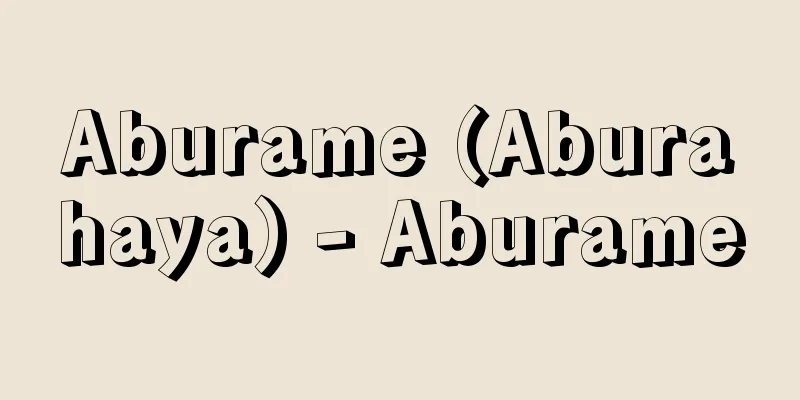Crucifixion - Crucifixion

|
A punishment in which a criminal is tied to a pillar and stabbed to death with a spear. Crucifixion has been practiced since ancient times in the West, including Judaism, ancient Greece, and Rome. It was mainly used to persecute Christians, and the crucifixion of Jesus Christ is well known. Emperor Constantine, who officially recognized Christianity in 313, abolished this practice, and after that the crucifixion was used for strangulation. In Japan, it was popular during the Sengoku period, but it also took place in the Edo period. Under the shogunate system, the places for crucifixion were Asakusa (Kozukahara in Senju) and Shinagawa (Suzugamori), but if a crime was committed in the province, it could be carried out at that place, and in the case of breaking through a checkpoint, crucifixion was to be carried out at that place. Parade was sometimes added and sometimes not. When the criminal arrived at the execution ground, he was taken off his horse and made to lie on his back on a pole for punishment, his legs and arms were tied to the crossbars, the pole was raised, and the roots were buried in a hole. First, the spears were crossed on the left and right in front of the criminal. This is known as a show spear. Then, shouting "Arya Arya" from both sides, they drew their show spears, immediately thrusting the tip of the spear from the left side of the corpse to his shoulder, twisting it once and drawing it out, then stabbing him with 20 to 30 spears each from the left and right, one after the other, and finally stabbing him in the throat from the left with the "final spear." The body was left exposed like that for three days and two nights. [Ryosuke Ishii] [Reference] |The remains of an execution ground opened in 1651 (Keian 4). Along with Kozukahara (Minamisenju, Arakawa Ward), it was one of the two major execution grounds during the Edo period. The base stones of the burning platform and the crucifixion platform still remain. Shinagawa Ward, Tokyo ©Yutaka Sakano "> Suzugamori Execution Site Source: Shogakukan Encyclopedia Nipponica About Encyclopedia Nipponica Information | Legend |
|
罪人を柱に縛り付けて槍(やり)で刺し殺す刑罰。磔は西洋でもユダヤ、古代ギリシア、ローマなどで古くから行われた。おもにキリスト教の迫害に用いられ、イエス・キリストの磔が有名である。313年キリスト教を公認したコンスタンティヌス帝はこれを廃止し、この後は架柱は絞殺用に使用された。 日本では、戦国時代に盛んであったが、江戸時代にも行われた。幕府の制度では、磔の刑場は浅草(千住(せんじゅ)の小塚原(こづかっぱら))と品川(鈴ヶ森)であったが、在方で悪事をした場合には、その場所で行うこともあり、また関所破りの場合には、その場所で磔に処する定めであった。引廻(ひきまわ)しは付加するときと、しないときがあった。科人(とがにん)が刑場に到着すると、馬から降ろし、罪木にあおむけに寝かせ、両足と両腕を横木に結び付け、罪木をおこし、根を穴の中に埋めた。初めに科人の面前で左右から槍先を交える。いわゆる見せ槍である。そして左右から「アリャアリャ」と声をかけて、見せ槍を引き、ただちに科人の左脇腹(わきばら)から肩先に、槍の穂先一尺余を突き出し、一つひねって槍を抜き、そのあと左右から、かわるがわる20から30本ぐらい突き、最後にのどに左から「止(とど)めの槍」を突いた。死体はそのまま三日二夜晒(さら)された。 [石井良助] [参照項目] |1651年(慶安4)に開設された刑場の跡。小塚原(荒川区南千住)とともに江戸時代の二大刑場であった。現在も火炙台、磔台の台石が残る。東京都品川区©Yutaka Sakano"> 鈴ヶ森刑場遺跡 出典 小学館 日本大百科全書(ニッポニカ)日本大百科全書(ニッポニカ)について 情報 | 凡例 |
>>: A stage with a raised platform
Recommend
Safety glass - Anzengarasu (English spelling) safety glass
Glass processed to minimize injury to the human b...
Exxon Corporation
An American oil company. One of the predecessors o...
Backward reasoning - Ushiromukisuiron (English spelling) backward reasoning
One of the reasoning methods used in research in t...
Japanese bush warbler - Japanese bush warbler
A deciduous shrub of the Caprifoliaceae family (A...
avoidance conditioning
...The degree of conditioning can be expressed as...
Dewa Mountains - Dewasanchi
A hilly mountain range stretching from southwest A...
Grass - Grass
The opposite of tree. Unlike trees, there is a li...
Chinbun of the Group - Marumaru Chinbun
A satirical magazine first published on March 24, ...
de Jussieu, AL (English spelling) deJussieuAL
…However, with the development of botany, the tru...
Jinbei - Jinbei
Also written as jinbei. (1) Generally called jinbe...
Salandra, Antonio
Born: August 13, 1853 in Troia, Puglia [Died] Dece...
Epotiocerus flexuosus (English spelling) Epotiocerusflexuosus
...Adults often fly to lights. In Japan, 12 speci...
Azuma
...Furthermore, in the late Jomon period, the Yay...
Solar spectrum
The spectrum of sunlight is a continuous spectrum...
NVV - N.V.V.
The Dutch trade union federation FNV (Ferdinand V...









